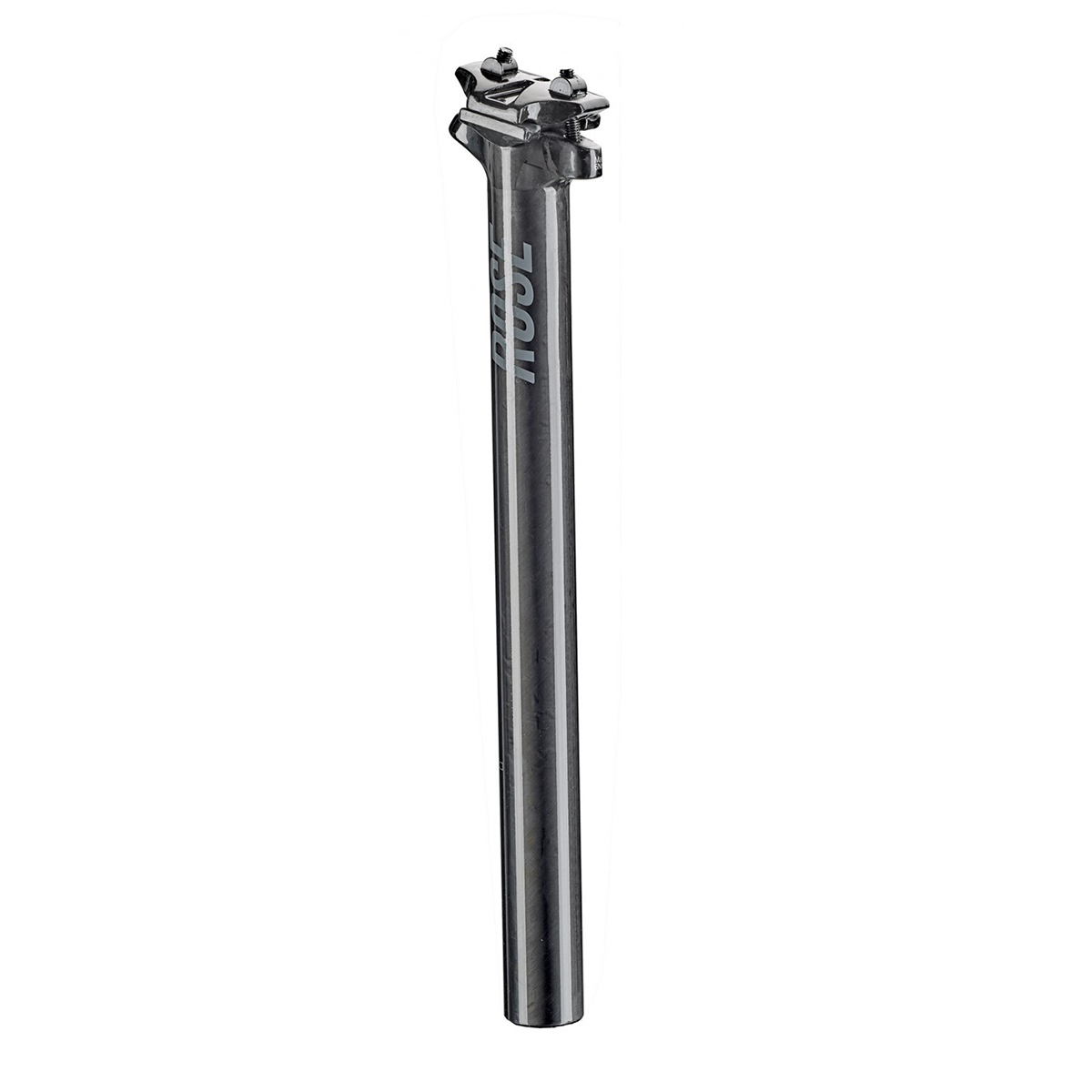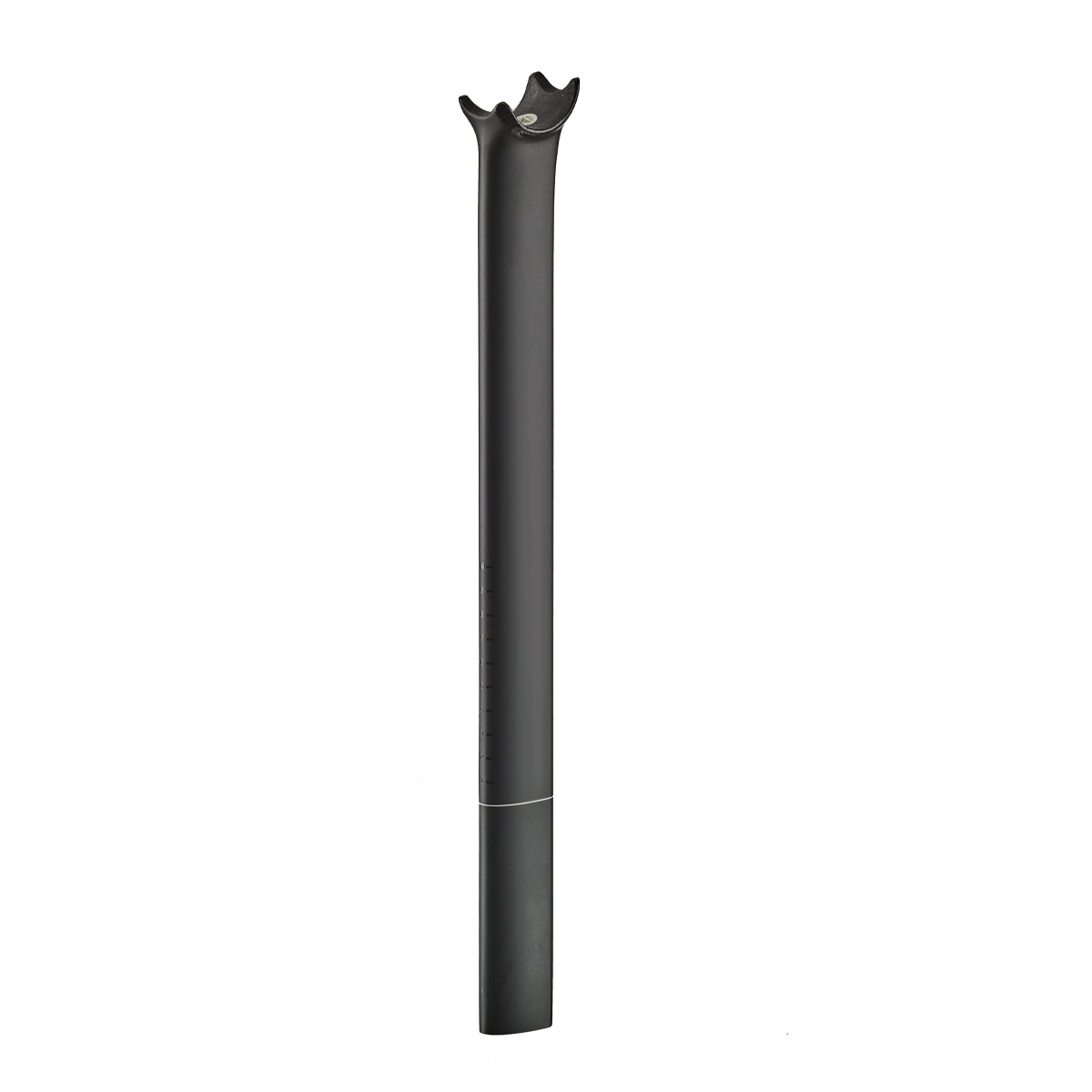Rigid seat posts – direct propulsion, clear ergonomics
Rigid seat posts are the simplest connection between you and your bike frame. They do not offer any damping and are particularly popular if you appreciate a low weight, freedom from maintenance and a fixed riding position, for example on a road bike, hybrid bike or urban bike.
But even if the principle sounds simple: When buying a rigid seat post, there are a few technical details to consider, from the correct diameter to the right clamp for your saddle.
What is a rigid seat post?
A rigid seat post is a rigid tube – usually made of aluminium or carbon – that is inserted into the seat tube of your bike. It holds the saddle in position and enables the desired seat height. Today, so-called patent seat posts are mainly used, which have an integrated saddle clamp with tilt adjustment. As opposed to suspended versions, it does not absorb shocks and remains unchanged in length. The advantage: maximum stability and a direct connection to the bike.Typical areas of use:
- Road, gravel
- City and urban bikes
- Hybrid bikes with a focus on simplicity
- E-bikes without authorisation requirement (e.g. pedelecs up to 25 km/h)
Advantages of rigid seat posts:
- Maintenance-free and robust
- Low weight, easy installation
- No play or movement under load
Special case: plain seat post & separate saddle clamp:
A plain seat post has a classic, straight design and is inserted directly into the seat tube of the bicycle frame. There is no saddle clamp at the upper end. A separate clamp is attached for this purpose – a clamping device that fixes the saddle to the frame and allows its angle to be adjusted.
This combination used to be widespread and is still used today on older or simpler bicycles. It enables a stable attachment of the saddle, but is often somewhat heavier and less comfortable to use compared to modern seat posts with an integrated clamp.
Material choice: Steel, aluminium or carbon?
The material depends on weight, budget and comfort perception:- Steel - rather rare today, stable, inexpensive, but heavy (occasionally still found on plain seat posts)
- Aluminium - the standard: stable, affordable, relatively light
- Carbon - lighter and with slightly damping flex, but more sensitive if clamped incorrectly (too high pressure load > torque wrench!)
Carbon seat posts can absorb small impacts through controlled flex – ideal for long-distance riders who prioritise comfort without wanting to rely on suspension.
How to find the right seat post
1. Which diameter fits my bike?
The seat post must fit exactly into the seat tube of your frame. Common diameters are:- 27.2 mm - often on road bikes, gravel bikes and older hybrid bikes
- 30.9 / 31.6 mm - common on modern bikes, more stability with less additional weight
- 34.9 mm - rather on very robust frames (e.g. MTB)
2. What length is required – and how deep into the frame tube can the post go?
Two dimensions are decisive:- Minimum insertion depth: In order to ensure that the post sits securely in the frame, a certain part (usually >90 mm) must be inserted into the tube.
- Maximum insertion depth: : The seat tube can be limited, especially on e-bikes with an integrated battery or with small frame sizes.
3. Offset – where do you sit in relation to the crankset?
The offset describes how far the clamping head of the seat post is offset. Normally the offset points backwards. However, in special areas of use, such as time trials/triathlons, it can also point clearly forwards. The offset significantly influences the pedalling ergonomics by changing the angle to the crankset and the riding position:
The right choice depends on your physical stature, the frame geometry (as well as the resulting intended use) and the desired riding position. The most common offset values are:
- 0 mm (straight post) - neutral, frame-oriented riding position
- 15-25 mm offset - with more distance to the handlebar, resulting in a slightly more stretched riding position, slightly flatter pedalling angle
Load capacity of a seat post – rider weight, system weight & intended use
The load capacity of a seat post indicates how much weight it can safely carry without compromising riding safety or durability. Classification is based on different test methods and standards (e.g. DIN EN 17406 & ASTM classification). A distinction is made between two values, among others.
Weight load:- Rider weight - includes rider + clothing + luggage (which directly loads the seat post; backpack, saddle bag etc.)
- System weight - includes bike + rider + clothing + luggage (total luggage)
Intended use:
The required load capacity also depends on the bike typeand intended use. For example:
- City and hybrid bike - moderate load, higher priority on comfort
- Mountain bike (XC, Trail, Enduro, Downhill) - high impact and torsional forces, increased load capacity required
Saddle clamp & saddle rails – what goes together?
In order to ensure that your saddle sits securely on the seat post, the saddle clamp and saddle rail dimensions must match. Here are the most important terms and tips for choosing:Saddle clamp and saddle rail
The seat post clamp fixes the saddle securely in position. It must match the saddle rails, i.e. the rails that connect the saddle to the seat post.The most common are:
- Round rails (usually Ø 7 mm): Standard on most bikes
- (Highly) oval rails: often 7 x 9 mm or 7 x 10 mm, typical for lightweight carbon saddles in the road bike sector (ATTENTION: clamping must be suitable for oval rails!)
For whom are rigid seat posts the right choice?
Rigid seat posts are particularly suitable for riders who appreciate a direct ride feel and deliberately go without damping. There are different advantages depending on the intended use:- Minimum weight
- Clear riding position without movement
- Low risk of defects due to dust and mud
- Practically maintenance-free, uncomplicated
- Stability when loading luggage
- Reduction to the essentials
How can I care for my seat post?
You should remove the seat post and clean the seat tube at regular intervals.
Remove old assembly grease (or carbon assembly paste for carbon seat posts) and replace it sparingly to prevent corrosion.
Otherwise, seat posts can possibly get stuck in the seat tube – removing them is then only possible with brute force, which can also irreparably damage the frame.
Conclusion: Simple, light and reliable – when the details are right
At first glance, rigid seat posts are not a complicated component, but they have to fit the bike, the saddle and the desired riding position exactly. The most important criteria:- Diameter matching the seat tube
- Insertion depth and length matched to frame size
- Offset depending on riding position and frame geometry
- Clamping compatible with saddle rails (round or oval?)
- Choice of material according to weight or comfort
Quick overview: Please pay attention to this
Seat post diameter✔ 27.2 / 30.9 / 31.6 / 34.9 mm - must fit the seat tube exactly
Insertion depth & length
✔ Observe minimum & maximum insertion depth – depending on the frame
Offset
✔ Suitable for the desired riding position – depending on the frame geometry and pedalling angle
Saddle clamp & saddle rail compatibility
✔ Suitable for saddle rails (usually 7 mm round rails), with carbon saddle rails often 7 x 9 mm or 7 x 10 mm (highly) oval
Material
✔ Aluminium (robust, inexpensive), carbon (lightweight, vibration-damping)
FAQ – frequently asked questions
How do I find the right diameter for my seat post?The diameter is often engraved on the old post (e.g. “Ø27.2”). Alternatively, the data sheet of your frame or a measurement with a calliper will help.
Can I ride a carbon post in an aluminium frame?
Yes, but only with carbon assembly paste and the correct torque.
How can I tell whether my saddle rails are round or oval?
Round rails have a uniform cross-section (usually 7 x 7 mm). Oval rails are significantly higher than they are wide (e.g. 7 x 9 mm). If in doubt, take a look at the saddle's technical data sheet.
What happens if the post protrudes too far or is pushed in too deep?
Too little insertion depth can damage the frame and/or the seat post. In such a case, sudden material failure can lead to serious injuries! Too much insertion is stopped by internal limitations (e.g. with battery frames). Therefore: Check dimensions and follow manufacturer's instructions.
;BackgroundColor=ffffff)
;BackgroundColor=ffffff)